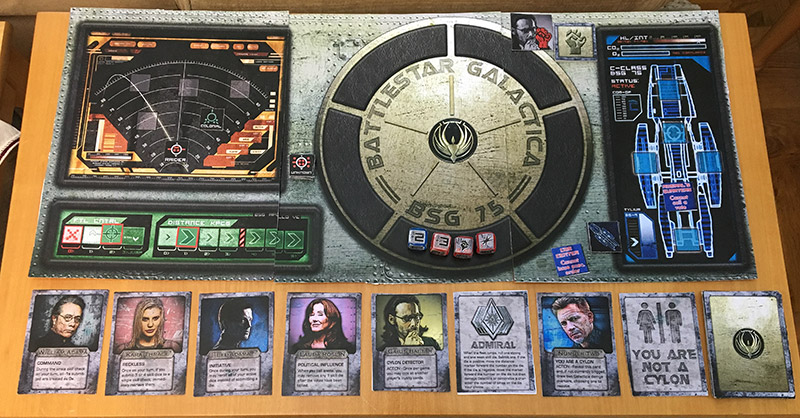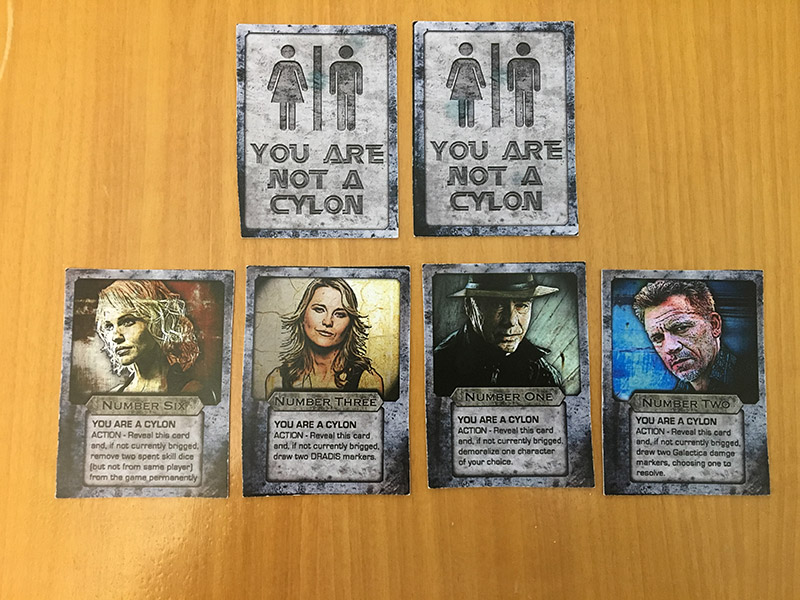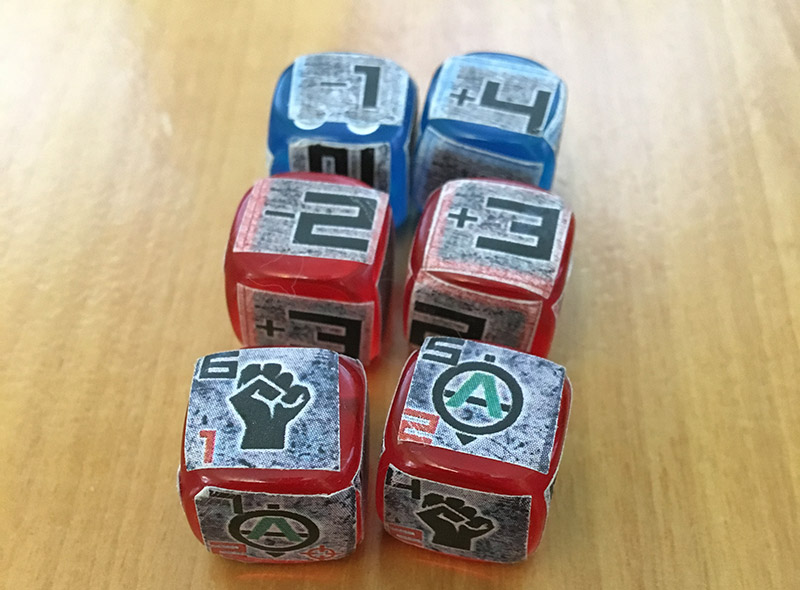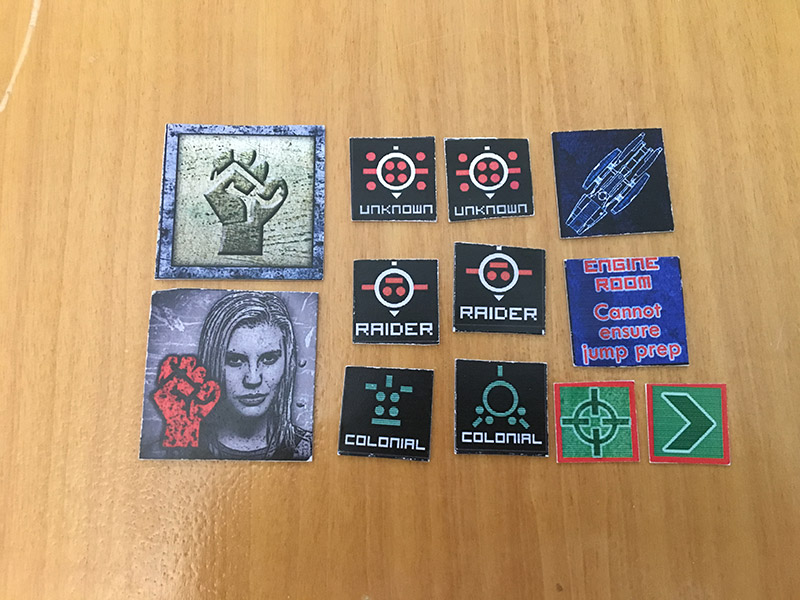Battlestar Galactica Express - Board Games You Can Play Blind
The Colonial Fleet is under constant threat from both external attacks as well as cybernetic spies planted deep within the humans. Admiral William Adama is doing everything in his power to prevent the end of mankind by their own creation, the Cylons.
Introduction
I was introduced to this hobby with a social deduction game, so that genre is very special to me. Another thing I really enjoy in this hobby are cooperative games. The combination of the two results in an extremely fun game, Battlestar Galactica Express.
BSG Express is a fan-made print and play game created by Evan Derrick that was later picked up by a publisher, slightly modified with a new theme and mechanics, and published under a new name, Dark Moon. Unfortunately, BSG Express is ‘officially’ not available anymore, but depending on how hard you look, you may still find the original PDF files online.
Now, if you are wondering why I am writing an analysis for this game and not Dark Moon, the simple answer is availability. Unfortunately, I failed to find a copy of Dark Moon here in Macedonia, so BSG Express was my only option.
This ended up being a long intro, and we are here to talk about visual accessibility, so without other delays, let’s briefly go through the game overview.
 Image showing the game components of BSG Express
Image showing the game components of BSG Express
Game Overview
-
Game name: BSG Express
-
Player count: 3-5
-
Playing time: 60 minutes
Before we start, I will briefly explain what the word Express means in the game’s title. If you are unfamiliar, there is a highly popular, out of print game called Battlestar Galactica, which was published by Fantasy Flight Games. This, original version of the game is much more complex and also lasts 3 hours or more to play. BSG Express takes the best parts of the original game and compresses them down to be enjoyed in a single hour.
In BSG Express, there are two teams: Humans and Cylons. Humans have a majority (3 humans in a 5 player game), but they have a harder win condition. The only way for the humans to win is to ‘jump’ the fleet past the number ‘6’ that is shown in the ‘jump distance’ tracker. To trigger a jump, you need to charge the jump drive 3 times. If you are not familiar with the tv show but have seen a Star Wars movie, this translates to charging the hyperspace drive and then jumping to light speed. Simply put, the humans win if they manage to escape from the frakking Cylons.
On the other hand, the Cylons win if one of the following happens:
-
The DRADIS (radar) has six Cylon Raiders. This means the fleet is overrun.
-
Galactica is destroyed by having all six damage markers on it.
-
All five characters are demoralized.
In the beginning of the game, players are randomly assigned one of five characters from the tv show. You can be William Adama, the admiral of the fleet; his son, Captain Lee ‘Apollo’ Adama; Kara ‘Starbuck’ Thrace, a hotshot fighter pilot; Laura Roslin, President of the Twelve Colonies; and finally, Gaius Baltar, a computer scientist. Each of these characters has their own special ability that they can perform during the game.
After the character cards are dealt the Admiral token is given to the player that picked William Adama. If you are playing with four or three players, and William Adama was not picked, there is a chain of command listed in the rules that shows who gets to be the Admiral. Next, each player gets a random loyalty card. These cards should be kept secret and they show whether you are a human or a Cylon, cough toaster cough.
 Image showing the secret loyalty cards
Image showing the secret loyalty cards
An interesting twist in the game is that around halfway through (when the fleet jumps to the 4th distance marker in the jump track or further), the players receive a new set of loyalty cards. Cylon loyalty cards take precedence, therefore if a player was a Cylon in the first round and then they received a Human loyalty card, they are still a Cylon. The Cylon loyalty cards also contain a power that is activated when the player reveals that they are a Cylon.
There also is a possibility for all the players to be humans in the first round of dealing loyalty cards. At such an event, the game is technically a fully cooperative game, however, you can never trust anyone, so it is fun to see accusations during the whole game only to realize at the end that in the beginning, you were all trying to help the humans win.
The main driver of the actions in BSG Express are dice. Each player has a total of four custom dice. Two of them are strong dice and are marked with blue borders, while the remaining two are weak dice and are marked with red borders. Whenever you roll the dice in the game, you do it in secret. Other players are not allowed to see what you have rolled, so each player needs to have a screen. There are positive and negative numbers on the dice. The strong dice have the following six numbers: -2, -2, -1, -1, +2, and +4. The weak dice have -2, -2, -1, -1, +1, and +3.
When you roll your dice, you always need to submit at least one of them depending on the action. The submitted dice are then considered as ‘spent’ dice. So now you have less dice to roll. There are special parts in the game where you retrieve your dice. This will make more sense when we explain the actions.
There also are two special dice, called the crisis dice. The icon shown on the dice can represent one of three things: unrest, which can cause players to be demoralized; an attack on Galactica, which can damage the ship; or new DRADIS contact, where you reveal a new DRADIS marker representing either a Cylon Raider or a Colonial ship on the DRADIS board. On the top left corner of the crisis dice, you have a difficulty number. On the bottom left corner, there is a number showing the consequence of the crisis. If the players manage to submit dice that have a sum equal to or higher than the difficulty of the crisis, the consequences do not happen.
Finally, some of the crisis dice faces contain a ‘target’ icon. This represents a ‘prepare to jump’ action. Regardless of whether the crisis was averted or not, the prepare to jump marker moves forward by the number of ‘target’ icons on the die.
 Image showing strong, weak and crisis dice
Image showing strong, weak and crisis dice
A player’s turn consists of multiple steps which can be narrowed down to: first you attempt to make something good for the humans, and then something bad happens. Here’s what happens during a player’s turn:
-
Retrieve spent dice - The player retrieve all of their spent dice.
-
Perform an action - The player chooses an action to perform, rolls their dice in secret, and submits the required amount of dice for that action. If they submit positive numbers, the action is successful. Otherwise, the action fails.
-
Roll crisis dice - The player rolls the crisis dice in secret, chooses one and submits it. Then everyone votes whether they will participate in a ‘skill check’, which means rolling dice to get a sum equal to or higher than the difficulty shown on the submitted crisis die to avert the crisis. Cylons may deliberately submit negative numbers to make sure the crisis is not averted. Players who do not participate in a skill check may retrieve a die (or two if they’ve spent all their dice).
-
Resolve crisis die - If the players fail to avert the crisis, the consequences need to be applied. For example, if the crisis was an attack on Galactica, and the consequence shows a value of 1, a random damage marker is put on Galactica.
-
Prepare to jump (conditional) - If the crisis die has a ‘target’ icon, you move the ‘prepare to jump’ marker forward.
-
Jump the fleet (conditional) - If the ‘prepare to jump’ marker reaches the final, third position, the fleet jumps. The player that has the admiral token takes one weak and one strong die and rolls them in secret. They choose one die and move the jump distance marker forward by the number shown on the die. If the number is negative, the marker still moves forward, but the admiral chooses whether to damage Galactica or demoralize a player.
 Image showing demoralized, Cylon Raider, Colonial ship, Galactica damage, and jump markers
Image showing demoralized, Cylon Raider, Colonial ship, Galactica damage, and jump markers
Now that we covered the flow of a player’s turn, let’s take a look at the different types of actions they can perform:
-
Destroy Cylon Raiders or Rescue Colonial ships - for each positive die the player submits, they can destroy a Raider or rescue a Colonial ship on the DRADIS board.
-
Repair Galactica - The player needs to submit a positive die to repair a single damaged section of the ship.
-
Boost morale - The player needs to submit a positive die to boost the morale of a demoralized player.
-
Perform character action - The player can perform the special action that their character has. For example, Gaius Baltar can investigate another player’s loyalty card.
-
Call a vote to brig / unbrig a player - Players can participate in a ‘skill check’ to put someone in the brig or release them if they are already in the brig. The difficulty of this skill check is 4.
-
Prepare for jump - The player needs to submit 2 dice that have a positive sum. If successful, the next crisis die is treated as having a ‘target’ icon, even if it doesn’t have one.
-
Issue an executive order - The current player may order another player to make an action on his behalf. The player receiving the order may accept or decline.
-
Reveal as a Cylon - If the player is a Cylon, they may reveal their identity. If they are not in the brig, their special Cylon power is activated. The special powers can be to damage Galactica, demoralize another player or other bad events for the humans. Revealed Cylons can no longer be put in the brig and they also play the rest of the game with only two dice, one weak and one strong.
The actions listed above may not all be available at all times. When Galactica is damaged, some of the actions may be unavailable until the damage of that section in the ship is repaired. For example, if the press room is damaged, you cannot boost the morale of a player, or if the weapons systems are damaged, you cannot destroy Cylon Raiders or rescue Colonial ships that are on the DRADIS board.
When a player is demoralized, they are not able to retrieve all of their dice and they can only retrieve one die at the beginning of their turn. This is a huge disadvantage because the only other way of retrieving dice is by not participating in a skill check (during the crisis phase or calling a vote to brig/unbrig someone). Players that are put in the brig also have very limited actions they can do. If the current Admiral is put in the brig, the next player in the chain of command becomes the new Admiral.
Problems for the humans start occurring when the human players roll badly and cannot complete their actions due to rolling negative numbers. If you look at the dice values I mentioned above, you will see that there is a higher chance of rolling negative numbers. This makes it easier for the Cylons to stay hidden and accuse other players of being Cylons due to the negative values they keep submitting.
When players are new to the game, the Cylons will have an advantage until the human players learn how to best manage certain crises. For instance, in one of our initial games, we did not think it was important to repair the part of the ship that needs to be fixed to call a vote to put someone in the brig early in the game. When we were finally sure that one of the players was a Cylon and wanted to put them in the brig before they revealed as a Cylon, we couldn’t because that action was not available due to the damage on Galactica. This small problem that we decided to ignore early cost us the game later, and the toasters won!
I remember back when I was watching the show and when the original Battlestar Galactica board game was released, I really wanted to buy the game, but eventually abandoned the idea because the game is simply too long and finding 4 other people willing to commit would be very hard. This game however, is a much lighter and more accessible game to casual players, It only took one ‘open handed’ test game to familiarize everyone with the game rules, and the actual game that we played afterwards was a blast. Hidden traitor games usually shine at higher player counts, and I strongly believe that BSG Express (and Dark Moon) is one of the best to do it at 5 players and in about an hour.
Visual Accessibility
Let’s see how well this game can be played by the visually impaired and blind players. BSG Express has plenty of hidden information which we’ve said in the past is a major visual accessibility problem.
The first thing we need to talk about are the hidden loyalty cards. There are a total of four different Cylon loyalty cards, each having a special action that occurs when a player reveals as a Cylon. In a five player game, only two of these cards at random will be in the game, while two of them are put away face down and not used. The simplest thing to do would be to mark the cards with tape or a little sticker. Putting a sticker in different corners for each card can help you identify which Cylon powers will be activated when you reveal.
Instead of marking my cards, I decided to try something else. I recently switched to an iPhone 6s from an old Nokia Lumia 820 Windows Phone due to the superior screen reader and smart color inversion capabilities. There are a few OCR (optical character recognition) apps out there, but one that is specifically created for the blind is called Seeing AI and developed by Microsoft. Seeing AI can read text out loud in real time, and is great for short sentences. So, when I am given a loyalty card in the game, I can leave the room (or plug headphones), fire up the app, and point the camera to my card. The screen reader reads the text for me and I am good to go. First accessibility crisis averted, hooray!
The second major problem is the hidden dice rolls. They are also custom dice, which makes the situation slightly worse. However, the number of dice is still quite low and you can simply use accessible dice instead. I use ordinary dice with pips that can be felt by touch. I have mentally assigned the custom values to each number as follows:
-
1 and 2 = -1
-
3 and 4 = -2
-
5 = +1 on week dice OR +2 on strong dice
-
6 = +3 on weak dice OR +4 on strong dice
When I have all four dice, I first roll two strong dice, check the values and memorize them, then roll the other two weak ones and check the pips. I then announce out loud the value I am submitting so that another player puts one of my actual custom dice on the board for everyone to see. My turn is slightly longer compared to other players, but 10-15 additional seconds does not really hurt the experience.
Next we need a solution for the crisis dice. Assigning the values mentally can be a bit of a problem here as you can easily mix things up. What I did for this was write down a table of all the 12 possible results, 6 for each die. Then, I roll two of the same accessible dice I mentioned above, and find out the number of pips by touch. Another player quickly reads out all the possible crisis outcomes and also announces a number associated with each outcome. When they finish reading, I tell them which value I choose based on what I rolled.
Another alternative that I personally have not tried would be to us a dice rolling app. I haven’t done much research in this front so I am not sure if there are any apps that play well with screen readers. If you are using any or if you have looked but haven’t found anything accessible, please let me know. With that, we conclude the discussion about hidden information.
The rest of the game is all public knowledge. You can simply ask a sighted player which part of Galactica is damaged if you forget, or ask a player which of their dice are spent to know how likely they are to participate in a vote or in a crisis skill check.
Since this is a print and play game, it’s very easy to modify your components and improve the accessibility yourself without worrying about damaging cards or tokens. This is one more game that we can add to the collection of ‘Board Games You Can Play Blind’!
Dark Moon comments
As I said in the introduction, the published version of BSG Express is known as Dark Moon and has a different theme as well as a few modifications to the game’s mechanics. I mainly want to make a few comments about the change with the crisis dice.
Instead of using crisis dice, Dark Moon uses cards. In general, cards are less accessible than dice because if you are blind, you either need to Braille label them, mark them in some way that will make sense to you, or use an OCR app like I do for the loyalty cards.
OCR apps can be good to use once or twice during a game, otherwise it can extend the game time by several minutes if you have to do it every time your turn comes. The speed and accuracy of the character recognition also depends on the contrast of the text on cards as well as how the text is stylized. I am not sure whether the crisis cards in Dark Moon have text, icons, or both. If you are planning to use an OCR approach, make sure the cards actually have text describing the crisis, otherwise you will need a different solution.
Because of this change from dice to cards for the crises, Dark Moon is a little less accessible for the visually impaired and blind, but I believe it would still be playable if OCR works or if you do not mind marking the cards.
Conclusion
BSG Express is a great mix of the cooperative and social deduction genres that uses the hidden traitor mechanic. Secret Hitler is one of my favorite games, but it is hard to get 7 or more players regularly to play that game. I also really enjoy cooperative games, but those games are not everyone’s cup of tea. With BSG Express you get to play a hidden traitor game at a lower player count as well as scratch that cooperative itch if your group does not enjoy cooperative games.
Even though the main driver of the game is hidden information (the dice rolls), it still manages to be very accessible due to the small number of dice and the fact that dice in general can be very accessible to the blind. When playing as a Cylon, not having to know who the other Cylon is, avoids the problems that other secret role games like Secret Hitler or The Resistance have.
I wouldn’t recommend BSG Express (or Dark Moon) as a game to introduce someone new to the hobby as it has slightly more rules than the usual gateway game, but it is a great stepping stone to move to something slightly more complex. I hope you enjoyed this post and as always, if you have any questions or comments feel free to drop them below, or you can also reach me us Twitter or via email.
Special thanks to my brother, Alpay, for his patience and spending multiple hours cutting and gluing the game’s components.
Leave a comment